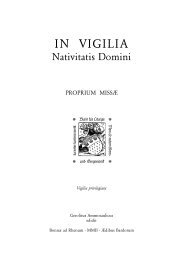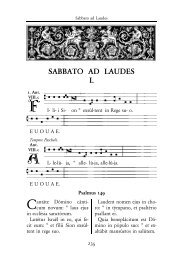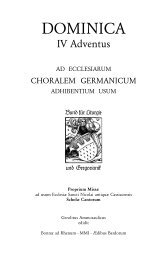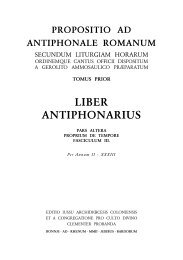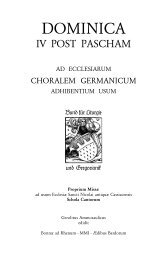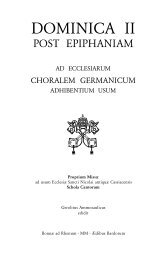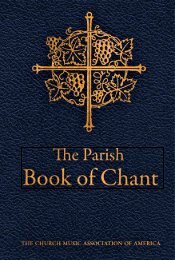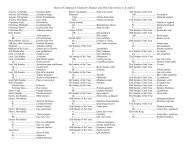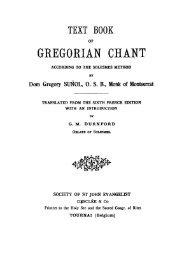The Bugnini-Liturgy and the Reform of the Reform - MusicaSacra
The Bugnini-Liturgy and the Reform of the Reform - MusicaSacra
The Bugnini-Liturgy and the Reform of the Reform - MusicaSacra
You also want an ePaper? Increase the reach of your titles
YUMPU automatically turns print PDFs into web optimized ePapers that Google loves.
<strong>The</strong> following studies 1 contain critical reflections on <strong>the</strong> Novus Ordo.<br />
We start with a seemingly unessential <strong>the</strong>me, <strong>the</strong> position <strong>of</strong> hymns in <strong>the</strong><br />
Office. It is, however, suitable to make clear some basic aspects. <strong>The</strong> second<br />
study concerns <strong>the</strong> very center <strong>of</strong> <strong>the</strong> liturgy: <strong>the</strong> Holy Week. <strong>The</strong> Divine<br />
Office is a much more important element in this affair than many regard;<br />
it st<strong>and</strong>s in <strong>the</strong> focus <strong>of</strong> <strong>the</strong> third chapter. <strong>The</strong> proper chant <strong>of</strong> <strong>the</strong> Mass is<br />
connected with <strong>the</strong> organism <strong>of</strong> <strong>the</strong> liturgical year, <strong>and</strong> <strong>the</strong> fifth section on<br />
<strong>the</strong> pericopes <strong>and</strong> calendar completes this <strong>the</strong>me.<br />
Three more tracts (published elsewhere) have been appended to <strong>the</strong><br />
series. <strong>The</strong> first addresses <strong>the</strong> friends <strong>of</strong> <strong>the</strong> Tridentine Movement, <strong>and</strong> its<br />
intention is to convince <strong>the</strong>m that <strong>the</strong> long-term alternative <strong>of</strong> <strong>the</strong> Novus<br />
Ordo is not simply <strong>the</strong> restoration <strong>of</strong> <strong>the</strong> 1962 Missal. <strong>The</strong> last two treatises<br />
are about music, but some remarkable <strong>the</strong>ological <strong>and</strong> pastoral issues are<br />
also discussed in <strong>the</strong>m.<br />
* * *<br />
By way <strong>of</strong> introduction, let me draw <strong>the</strong> lines immediately so as to separate<br />
myself from certain views on <strong>the</strong> one h<strong>and</strong>, <strong>and</strong> on <strong>the</strong> o<strong>the</strong>r to exclude<br />
some o<strong>the</strong>r topics, albeit important, from discussion:<br />
1. <strong>The</strong> critical approach to <strong>the</strong> "<strong>Bugnini</strong> <strong>Liturgy</strong>" 2 presented here reflects<br />
nei<strong>the</strong>r disobedience toward higher church authority nor a practical opposition<br />
to liturgical regulations. In everyday life, I am ready to accommodate<br />
myself to <strong>the</strong> currently valid liturgical prescriptions even though as an expert<br />
dealing with <strong>the</strong> liturgy, I consider <strong>the</strong>m wrong or unsuccessful in many<br />
respects. Thus, my remarks are made in a spirit <strong>of</strong> service <strong>and</strong> not <strong>of</strong> contestation.<br />
1 Since some <strong>of</strong> <strong>the</strong>m have been published separately, certain <strong>the</strong>matic repetitions could<br />
not be entirely avoided.<br />
2 My expression '<strong>Bugnini</strong> <strong>Liturgy</strong>' was earlier criticized by saying that <strong>the</strong> new liturgy was<br />
elaborated by commissions <strong>and</strong> not a single person, <strong>and</strong> was introduced under <strong>the</strong><br />
authority <strong>of</strong> <strong>the</strong> Pope <strong>and</strong> <strong>the</strong> Curial Office concerned. <strong>The</strong>se readers do not seem to<br />
have noticed <strong>the</strong> essentially provocative nature <strong>of</strong> <strong>the</strong> title. <strong>The</strong> name was naturally not<br />
meant to attribute this liturgy to one person, but had to do with <strong>the</strong> contents: It symbolized<br />
that <strong>the</strong> new liturgy is not a recent form <strong>of</strong> <strong>the</strong> Roman rite, nor ano<strong>the</strong>r stage <strong>of</strong> an organic<br />
development, but a hastily created, voluntarist invention, in which individual ideas<br />
<strong>and</strong> ambitions played a decisive, dominant role. This has remained so as regards <strong>the</strong> content<br />
even if it had received /^/approbation.<br />
10




